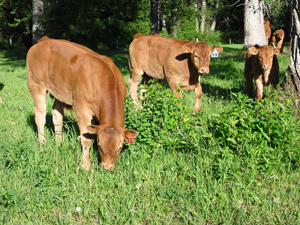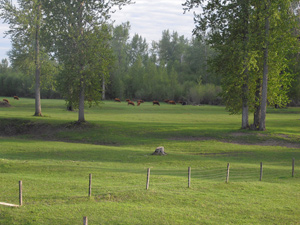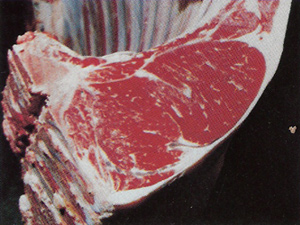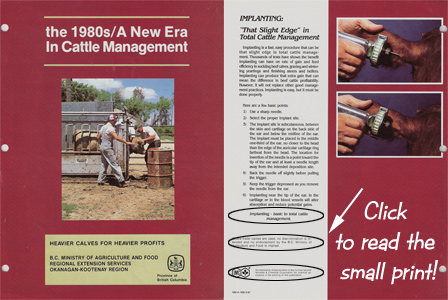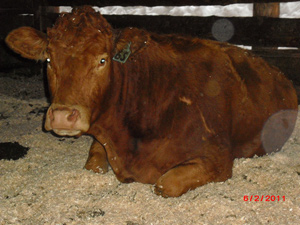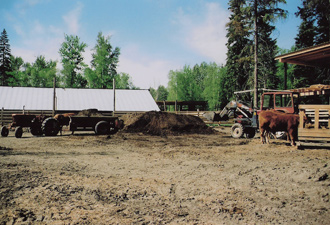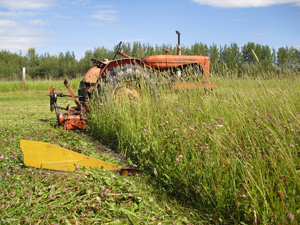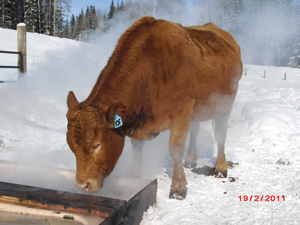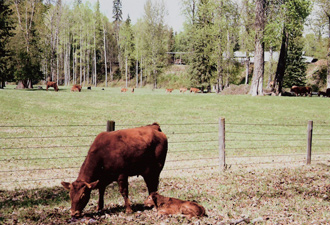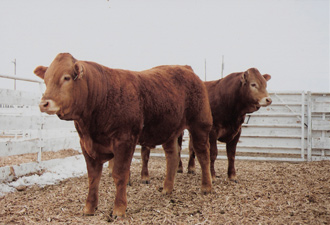
We could write pages on all the things we do to make our farm healthier and more sustainable. However, it's more interesting to use photos, if a picture's worth a thousand words..... But what's difficult to illustrate is what we don't do. With pictures and text we'll try to convey our methods and our concerns.
We do not subject our animals to stress
We think that stressed animals are likely unhealthy animals. Our cows, being all the same breed and together for generations have little internal herd stress. Because they stay here until slaughter, there are none of the industrial strains other calves endure.
There's no mass exodus after weaning to the auction, no days and nights packed into pens amongst hundreds of pens filled with thousands of other stressed and bawling youngsters. No chasing up and down confusing alleyways encouraged along with 50,000 volt cattle prods in the hands of harried, underpaid, temporary workers. No swirling around a brightly lit, chaotic, deafening sales ring, no freezing truck rides to feedlots in other provinces beneath a hundred other traumatized strangers.
No implants of hormones, rounds of vaccine or antibiotics hastily jabbed into you with the same needle that stuck the last thousand head to combat the various bacterias or the effects of a questionable high protein diet. No burning, pour on, absorb-through-the-skin parasitic controls. No endless weeks in featureless, crowded, dirty, windy, shelter-less pens filled with the condemned. No resorting, reloading and transporting to a mega packing plant. No contact with the, "We don't get paid enough to care" workforce. No, our animals just roam around and eat with their friends and relatives until it's time to go.
We are very concerned about our guys from the moment of conception to the time they are dropped off at the abattoir. Our butcher is concerned about them because of his conscience, consideration for his customers health and his business.
We do not feed our cattle grain
Cattle just aren't meant to eat grain. So why are they fed it? Well there's an old joke that explains it pretty well. Two pig farmers are chatting at the fence one day and one sez, "How come you let your hogs run loose in the bush like that? Why don't you pen 'em up, grain 'em up, get 'em up to weight and off to market a whole lot quicker?" The other guy sez, "What's time to a pig?" Time is money, or maybe it's just an opportunity for someone to market a shortcut.
Time is money. Put them critters on the cheapest, highest protein diet you can find (and that can be from quite a few unsavoury sources) for maximum weight gain over the shortest period of time; daily gain versus daily cost. These "hot" feeds, especially barley, super acidify their stomachs. Something in this disturbance very often causes numerous large cysts in the hosts' liver. Even at our little local facility many livers are condemned for cysts by the meat inspector. We find this both frightening and disgusting.
The feeding of grain, which does speed growth, also results in excess fat, which we, the consumer have been trained to crave. But this calorie intense fat is not good for us .The chemical balance of both it and the meat have been altered by the very feed which created it. As a result; "The 'good fatty' acids, collectively known as Omega-3 and conjugated linoleic (CLA), are in short supply in the modern American diet, and one may be well advised to take advantage of sources which provide them, such as the meat and dairy products of grass fed animals."----Bill Elkins, M.D., Associate Professor Emeritus, Dept. of Pathology, University of Pennsylvania School of Medicine. (For more info please go to EatWild.com and learn how these essential fatty acids become reduced in the grain fed animal.)
Furthermore, in this fat, is where any chemical residue will accumulate, be it from fertilizers, the herbicide used to desiccate the grain pre-harvest, the hormones used to stimulate growth, to the vaccines, antibiotics and anti-parasitics used to speed the gain and survive the feed lot. Any excess fat trimmed off at the packers will be buried in the ground beef or the processed products. They bought by the pound and they are going to sell by the ounce. Everything salvageable will be sold.
As if all this weren't bad enough, it's estimated that the average feed lot beef has used over one thousand litres of fossil fuel from birth to finish, in the production of feed and in transportation. It seems, "We have succeeded in industrializing the beef calf, transforming what was once a solar-powered ruminant into the very last thing we need: another fossil-fuelled machine." --Michael Pollan, "Power Steer", The New York Times. This is a must read.
A locally raised grass fed animal probably uses about a sixteenth of this, which is still quite a lot. Getting off grain fed beef is probably the easiest, single most important thing we can do for our internal and external environments.
We do not employ growth hormones
For that "slight edge" as the advertisement reads. We won't risk anybody's health for a ten or twenty dollar per head gain but if you raise a thousand calves or run a hundred thousand head through your feed lot a year well.......just do the math.
Cleverly disguised as a Ministry of Agriculture information guide this is but a glossy ad promoting the use of growth hormones, stating, "Cattlemen can't afford to pass up this sort of investment opportunity"
We don't use any pharmaceuticals of any sort
Uncrowded, unstressed, well looked after animals, just don't seem to get sick. We do get the occasional fatality, but we've yet to see a shot that will mend a broken leg,a split pelvis or shoo a bunch of ravens off a weak new born. All those ads about the necessity of dousing your cattle twice a year with soak in pesticides to control parasites (which we had not done) had us really worried. So the last animal we took to the butcher (which was eight years old) we had the meat inspector really go over. It was absolutely clean.
We do not use chemical fertilizers or herbicides
The care and comfort of our animals is our primary concern. Do this and everything else falls into place. Cows need a dry place to eat, hang around and lie down. If you look around at most operations, this link is missing. Why? "Cause it's a lotta work. You need roofs, floors, bedding and the equipment and time to deal with it. We are fortunate to have the availability of shavings from the planer mills to use as bedding.
We use about 30 tons a year, and it's far from free. But, this one component makes our farm work. Wood shavings liberally applied over concrete floors, covered by roofs, make an irresistible environment for cattle.
For the six months of every year that they are fed hay, our cows, which run free, only leave the comfort of the barn, for water, (which we purposely placed at a distance) or to catch a little sun. Consequently and surprisingly about 99% of all their waste is deposited on those shavings. The urine which contains most of the nitrogen is absorbed and captured.
Cleaning is required weekly, and by spring we have about one hundred eighty tons of organic fertilizer. This goes right back onto the hay fields. Our yields (dependent on rainfall) have increased every year since we began.
We also have a bunch of clean, happy, healthy cows that consume about 20% less feed than cows that laid in the mud or snow all winter. We have no build up in the yards, less mud and few flies.
The average beef cow lasts about eight years, our oldest, a daughter of one of our original six, is fifteen and expecting, we think she will make twenty. A little bit of care seems to go a long way.
Our pastures are fertilized by the grazing cows, from the huge amount of leaves from all those cottonwoods we left and by the regular flooding of the Fraser River. As for herbicides, well it's hardly worth the mention.
The only problematic weeds we have are thistles. For a few mornings every summer I take a scythe and go hunting. I call it herb-a-scything.
Anymore. We used to, but we sure don't miss it. When we were raising breeding stock, you were constantly fighting the calendar. Bulls for the bull test had to be born before March 31 and even those born after Valentines were in a different group and most didn't make the grade. Heifers were supposed to calve before the age of two and with puberty not coming until thirteen or fourteen months, it was nearly impossible to get them to calve in time. Midnight checks at minus thirty, soaking wet calves coming out of a hundred degree womb into that cold, didn't have a very easy start. Now we calve in late March and April and when they're about six weeks old the grass comes, the milk pours, they are big enough to take advantage of it and the world is all right.
We do not castrate our young bull calves
Why? Bulls,as opposed to steers, gain muscle (meat). Steers may gain weight (meat and fat) faster but that's not what we're after. Castration is mostly for the benefit of the feedlot. Early maturing young males can wreak havoc on their fellow pen mates in a crowded pen, and we're not talking about fighting although that too can be a problem. The adrenaline rushes change the composition of the muscles and they become very stringy and tough, it makes great ground beef but for the industrial packers there are lots of instantly usable, cheap, old dairy cows for that.
We believe and records show that castrated beings can exhibit diverse physical abnormalities probably due to unbalanced hormonal levels.
Limousin cattle are the slowest breed to reach puberty at around 13 to 14 months, as opposed to as early as 6 to 8 months in other breeds. So in August the year after their births we gather up all the larger boys and off they go. They gain the benefits of another summer on grass, best type of growth and a more natural hormonal balance. We thought this a unique way of managing our stock, but have recently found out that the French started this over a hundred years ago calling it ,Veau de Lyon, young bull beef 13 to 14 months old.



